Corn Harvester Bearing Fault Diagnosis Based on ABC-VMD and Optimized EfficientNet
Abstract
:1. Introduction
2. Methodology
2.1. Variational Modal Decomposition (VMD) and Artificial Bee Colony Optimization
2.2. Optimization of EfficientNet
3. Bearing Fault Diagnosis Process and Model
4. Experimental Analysis
4.1. Case Western Reserve Experimental Dataset Validation
4.1.1. Dataset Introduction
4.1.2. Construction of the Stockwell Time–Frequency Graph Sample Set
4.1.3. Comparison of Evaluation Functions
4.1.4. Comparison between Classification Models
4.2. Test Verification of 4YZB-8B Self-Propelled Corn Harvester
4.2.1. Comparison between High Parameter Models
4.2.2. Comparison between Existing State-of-the-Art Studies
| Test | Method Presented in [33] | RBM | DBN | DBM | AE | CNN | RNN | Method Presented in [35] | Proposed Method |
|---|---|---|---|---|---|---|---|---|---|
| First test | 86.2% | 85.2% | 94.2% | 95.2% | 93.2% | 80.4% | 90.2% | 97.2% | 98.7% |
| Second test | 98.6% | 79.2% | 93.7% | 93.2% | 94.6% | 78.6% | 88.3% | 89.2% | 98.3% |
| Third test | 97.2% | 78.6% | 92.1% | 94.6% | 91.7% | 72.1% | 87.3% | 96.8% | 99.1% |
5. Conclusions
Author Contributions
Funding
Institutional Review Board Statement
Data Availability Statement
Conflicts of Interest
References
- Chu, B.; Qi, Z.; Sun, L.; Han, M.; Zhao, L.; Li, H. Design and test of large verticalcrusher for cane stalk. J. Chin. Agric. Mech. 2021, 42, 93–100. [Google Scholar]
- Shi, J.; Wu, X.; Liu, X.; LIU, T. Mechanical fault diagnosis based on variational mode decomposition combined with deep transfer learning. Trans. Chin. Soc. Agric. Eng. (Trans. CSAE) 2020, 36, 129–137. [Google Scholar]
- Wang, H.; Deng, S.; Yang, J.; Liao, H. Incipient fault diagnosis of rolling bearing based on VMD with parameters optimized. J. Vib. Shock 2020, 39, 38–46. [Google Scholar]
- Dong, L.; Chen, Z.; Hua, R.; Hu, S.; Fan, C. Research on diagnosis method of centrifugal pump rotor faults based on IPSO-VMD and RVM. Nucl. Eng. Technol. 2023, 55, 827–838. [Google Scholar] [CrossRef]
- Ye, M.; Jia, M. Rolling Bearing Fault Diagnosis Based on VMD-MPE and PSO-SVM. Entropy 2021, 23, 762. [Google Scholar] [CrossRef]
- Liu, J.; Quan, H.; Yu, X.; He, K.; Li, Z. Rolling Bearing Fault Diagnosis Based on Parameter Optimization. Acta Autom. Sin. 2022, 48, 808–819. [Google Scholar]
- Liang, T.; Lu, H. A Novel Method Based on Multi-Island Genetic Algorithm Improved Variational Mode Decomposition and Multi-Features for Fault Diagnosis of Rolling Bearing. Entropy 2020, 22, 995. [Google Scholar] [CrossRef]
- Li, X.; Ma, Z.; Kang, D.; Li, X. Fault diagnosis for rolling bearing based on VMD-FRFT. Measurement 2020, 155, 107554. [Google Scholar] [CrossRef]
- Li, Z.; Jiang, W.; Zhang, S.; Sun, Y.; Zhang, S. A Hydraulic Pump Fault Diagnosis Method Based on the Modifified Ensemble Empirical Mode Decomposition and Wavelet Kernel Extreme Learning Machine Methods. Sensors 2021, 21, 2599. [Google Scholar] [CrossRef]
- Bai, R.; Xu, Q.; Meng, Z.; Cao, L.; Xing, K.; Fan, F. Rolling bearing fault diagnosis based on multi-channel convolution neural network and multi-scale clipping fusion data augmentation. Measurement 2021, 184, 109885. [Google Scholar] [CrossRef]
- Niu, G.; Wang, X.; Golda, M.; Mastro, S.; Zhang, B. An optimized adaptive PReLU-DBN for rolling element bearing fault diagnosis. Neurocomputing 2021, 445, 26–34. [Google Scholar] [CrossRef]
- Huo, C.; Jiang, Q.; Shen, Y.; Qian, C.; Zhang, Q. New transfer learning fault diagnosis method of rolling bearing based on ADC-CNN and LATL under variable conditions. Measurement 2022, 188, 110587. [Google Scholar] [CrossRef]
- Ding, C.; Chen, R.; Huang, Y.; Liu, F.; Liu, H.; Xiao, A. Application study of reparameterized VGG network in rolling bearing fault diagnosis. J. Vib. Shock 2023, 42, 313–323. [Google Scholar]
- Wang, H.; Sun, W.; He, L. Rolling Bearing Fault Diagnosis Using Multi-Sensor Data Fusion Based on 1D-CNN Model. Entropy 2022, 24, 573. [Google Scholar] [CrossRef] [PubMed]
- Gu, X.; Yu, Y.; Guo, L. CSWGAN-GP: A new method for bearing fault diagnosis under imbalanced condition. Measurement 2023, 217, 113014. [Google Scholar] [CrossRef]
- Nijaguna, G.S.; Babu, J.A.; Parameshachari, B.D.; de Prado, R.P.; Frnda, J. Quantum Fruit Fly algorithm and ResNet50-VGG16 for medical diagnosis. Appl. Soft Comput. 2023, 136, 110055. [Google Scholar] [CrossRef]
- Zhang, L.; Du, J.; Dong, S.; Wang, F.; Xie, C.; Wang, R. AM-ResNet: Low-energy-consumption addition-multiplication hybrid ResNet for pest recognition. Comput. Electron. Agric. 2022, 202, 107357. [Google Scholar] [CrossRef]
- Gai, J.; Zhong, K.; Du, X. Detection of gear fault severity based on parameter-optimized deep belief network using sparrow search algorithm. Measurement 2021, 185, 110079. [Google Scholar] [CrossRef]
- GUANG, J.; LINAG, J.; LIU, Y. Plant image classification algorithm based on improved EfficientNet. Transducer Microsyst. Technol. 2022, 41, 136–139. [Google Scholar]
- Liu, Z.; Xing, J.; Wang, H.; Han, F.; Gu, F. Fault diagnosis of rolling bearings based on VMD and fast spectral kurtosis. J. Electron. Meas. Instrum. 2021, 35, 73–79. [Google Scholar]
- Hua, L.; Xing, W.; Tao, L.; Li, S.; Zhang, B.; Zhou, G.; Huang, T. Composite fault diagnosis for rolling bearing based on parameter-optimized VMD. Measurement 2022, 201, 111637. [Google Scholar]
- Luo, C.; Cheng, S.; Xu, H.; Li, P. Human behavior recognition model based on improved EfficientNet. Procedia Comput. Sci. 2022, 199, 369–376. [Google Scholar] [CrossRef]
- Amigó, J.M.; Dale, R.; Tempesta, P. Complexity-based permutation entropies: From deterministic time series to white noise. Commun. Nonlinear Sci. Numer. Simul. 2022, 105, 106077. [Google Scholar] [CrossRef]
- Wang, X.; Zheng, J.; Zhang, J. A novel optimal demodulation frequency band extraction method of fault bearing based on power spectrum screening combination-gram. Mech. Syst. Signal Process. 2022, 174, 109104. [Google Scholar] [CrossRef]
- Zeng, X.; Lu, X.; Liu, Z.; Jin, Y. An adaptive fractional stochastic resonance method based on weighted correctional signal-to-noise ratio and its application in fault feature enhancement of wind turbine. ISA Trans. 2022, 120, 18–32. [Google Scholar] [CrossRef]
- Arranz, R.; Paredes, Á.; Rodríguez, A.; Muñoz, F. Fault location in Transmission System based on Transient Recovery Voltage using Stockwell transform and Artificial Neural Networks. Electr. Power Syst. Res. 2021, 201, 107569. [Google Scholar] [CrossRef]
- Li, H.; Liu, T.; Wu, X.; Chen, Q. An optimized VMD method and its applications in bearing fault diagnosis. Measurement 2020, 166, 108185. [Google Scholar] [CrossRef]
- Cui, Y.; Hu, W.; Rahmani, A. A reinforcement learning based artificial bee colony algorithm with application in robot path planning. Expert Syst. Appl. 2022, 203, 117389. [Google Scholar] [CrossRef]
- Kang, W.; Zhu, Y.; Yan, K.; Ren, Z. Weak Fault Extraction of Rolling Element Bearings Based on CSES and MED. J. Vib. Meas. Diagn. 2021, 41, 660–666+827. [Google Scholar]
- Xu, H.; Jiao, G.E.; Zhang, W.J.; Chen, Y.M. Classification algorithm for structured imbalanced data based on convolutional neural network. Comput. Eng. 2023, 49, 81–89. [Google Scholar]
- Zhang, H.; Sheng, Y.J.; Huang, Z.L.; Liu, C.; Cao, Y. W-DenseNet-based fault diagnosis model of pressure-reducing valve with unbalanced samples. Control Decis. 2021, 37, 1513–1520. [Google Scholar]
- Lei, Y.; Yang, B.; Du, Z.; Lv, N. Transfer Diagnosis Method for Machinery in Big Data Era. J. Mech. Eng. 2019, 55, 1–8. [Google Scholar] [CrossRef]
- Kumar, P.; Kumar, P.; Hati, A.S.; Kim, H.S. Deep Transfer Learning Framework for Bearing Fault Detection in Motors. Mathematics 2022, 10, 4683. [Google Scholar] [CrossRef]
- Kumar, P.; Khalid, S.; Kim, H.S. Prognostics and Health Management of Rotating Machinery of Industrial Robot with Deep Learning Applications—A Review. Mathematics 2023, 11, 3008. [Google Scholar] [CrossRef]
- Xu, K.; Kong, X.; Wang, Q.; Yang, S.; Huang, N.; Wang, J. A bearing fault diagnosis method without fault data in new working condition combined dynamic model with deep learning. Adv. Eng. Inform. 2022, 54, 101795. [Google Scholar] [CrossRef]
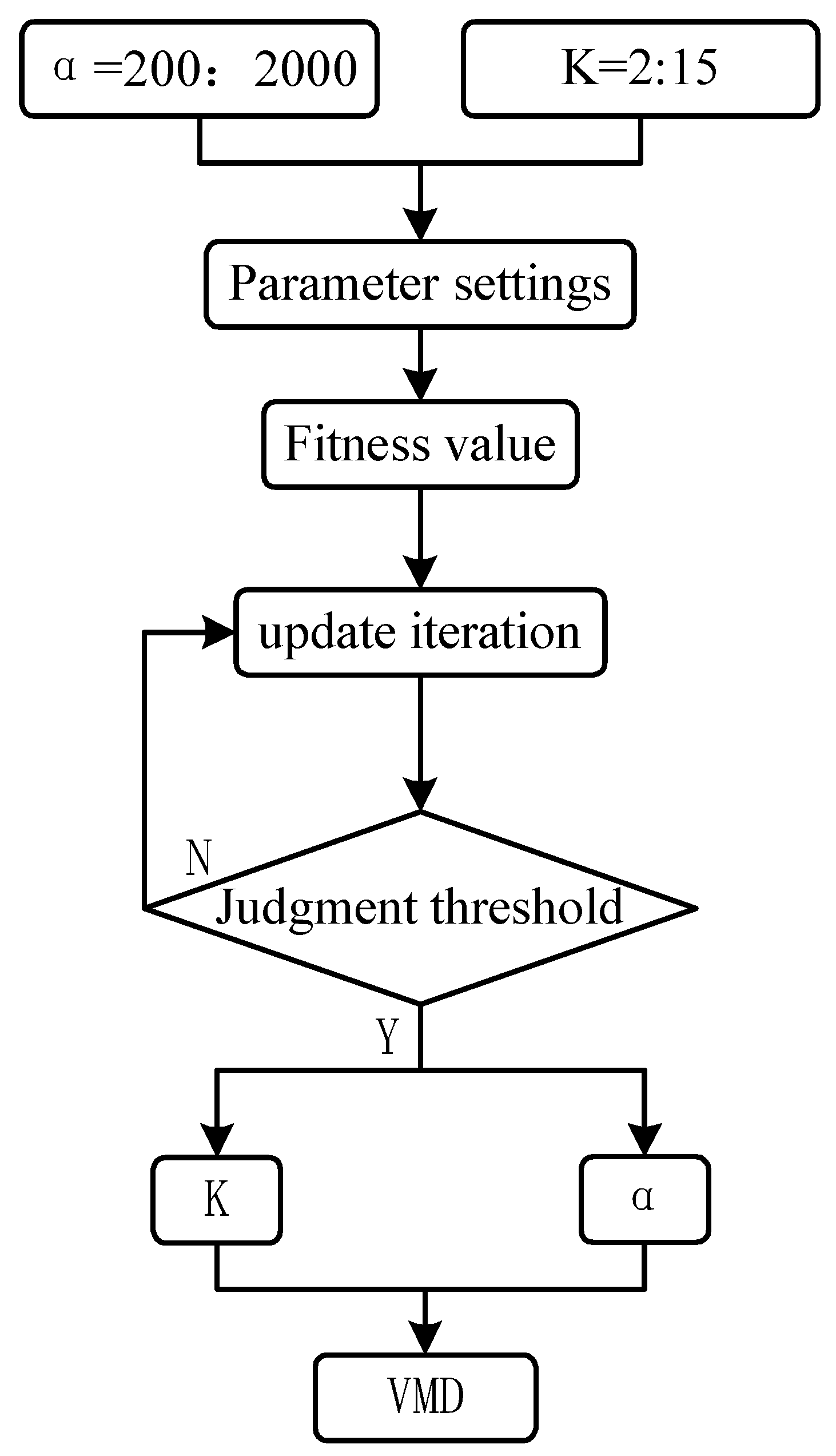


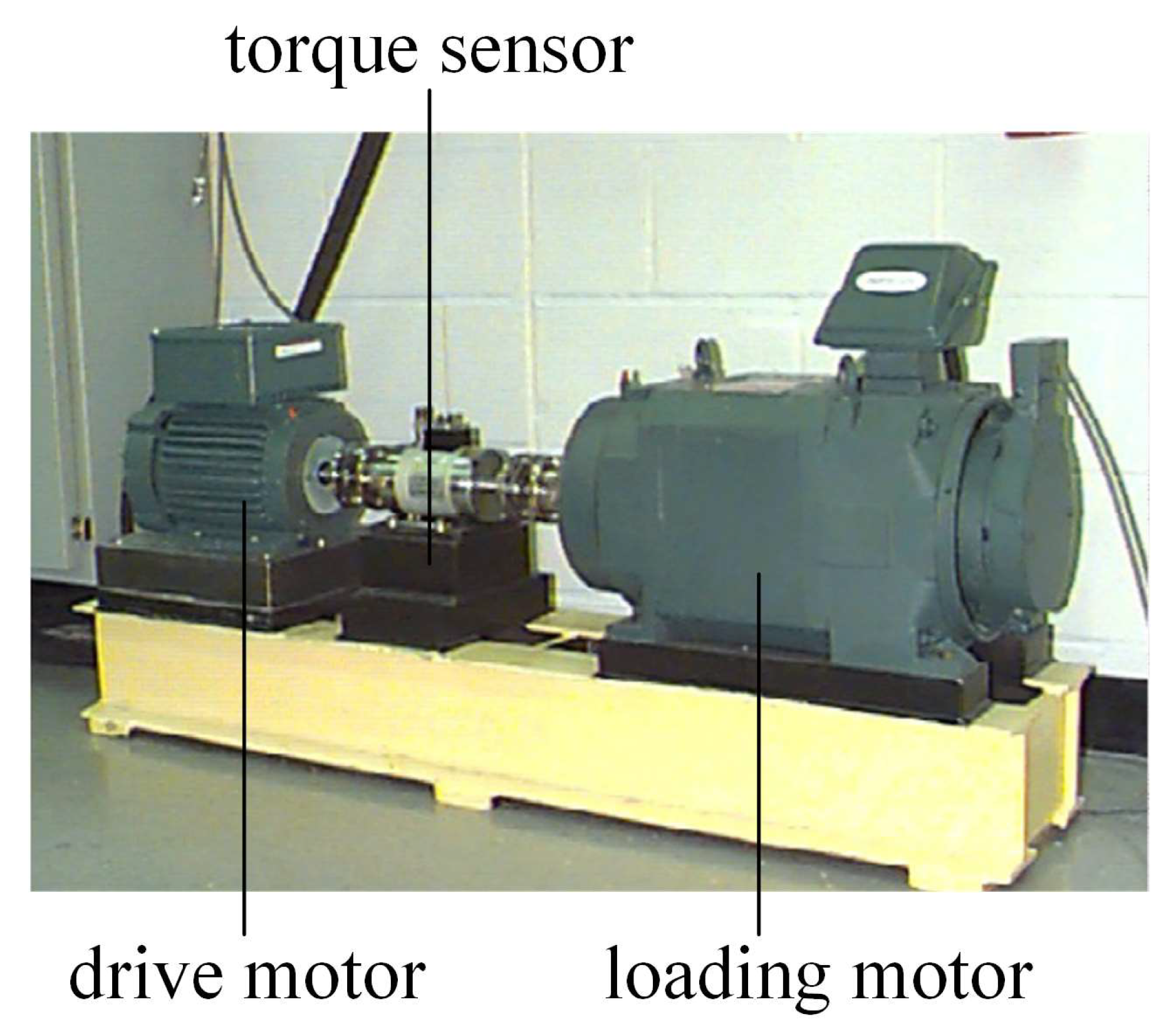

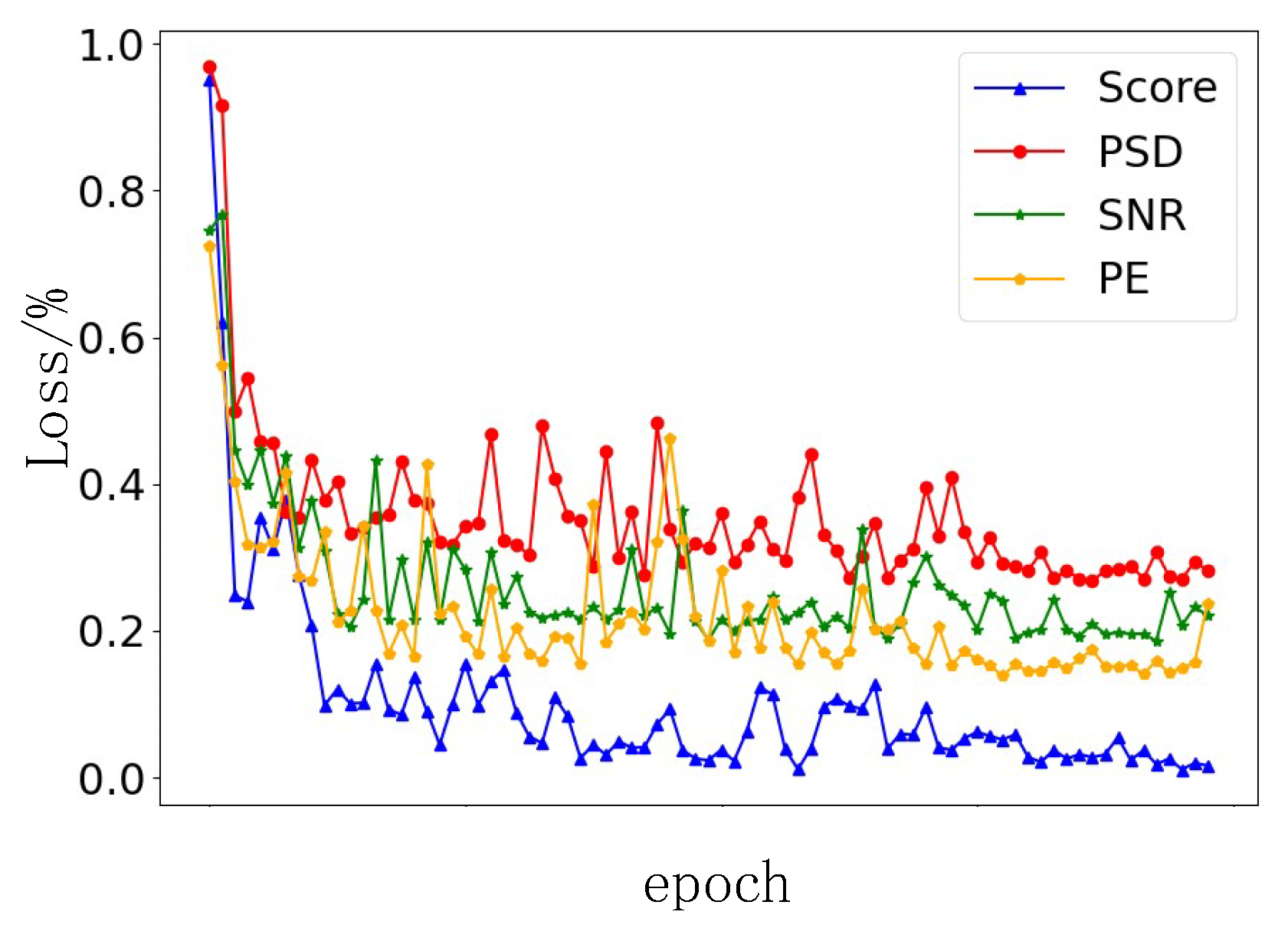
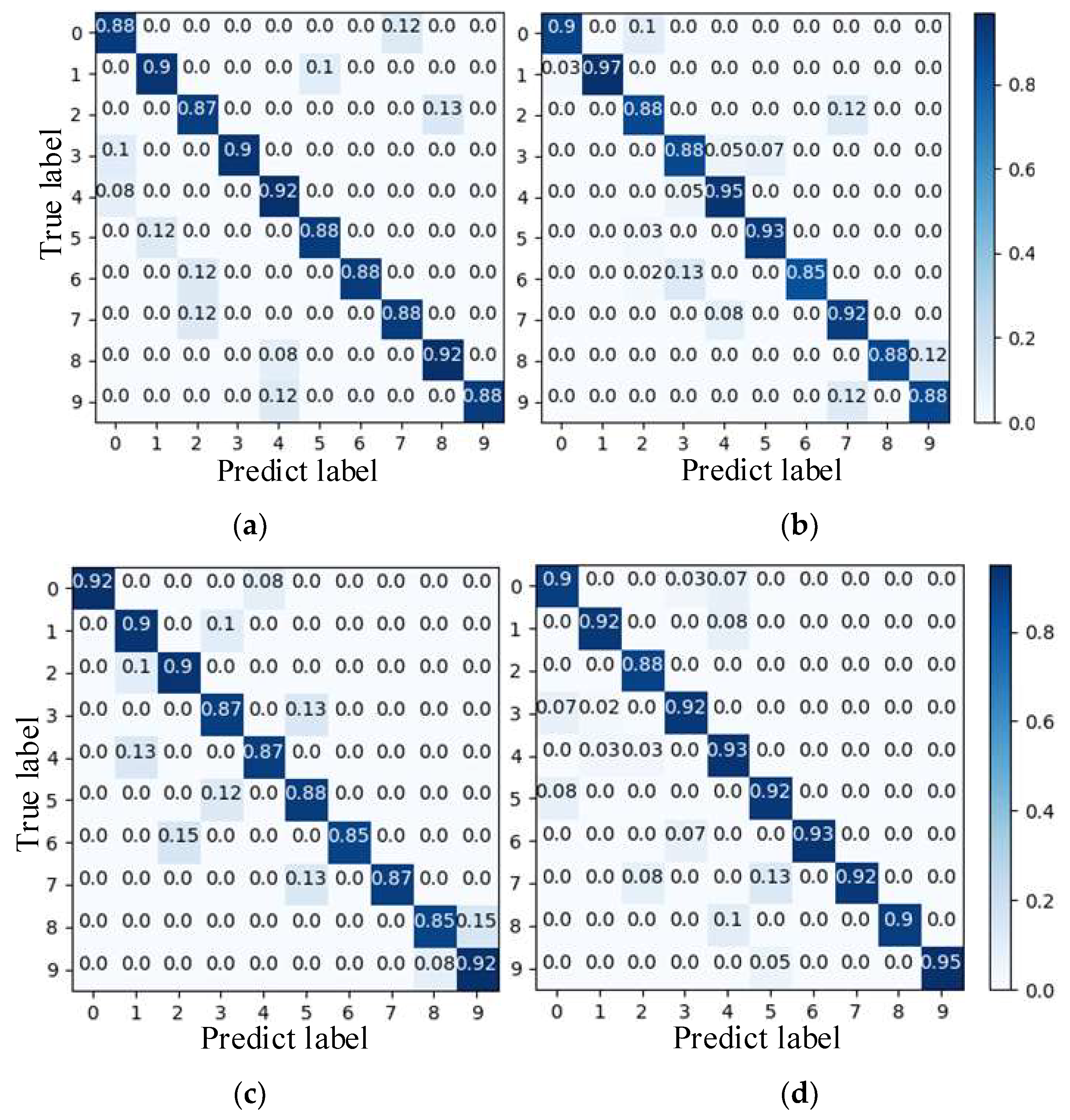

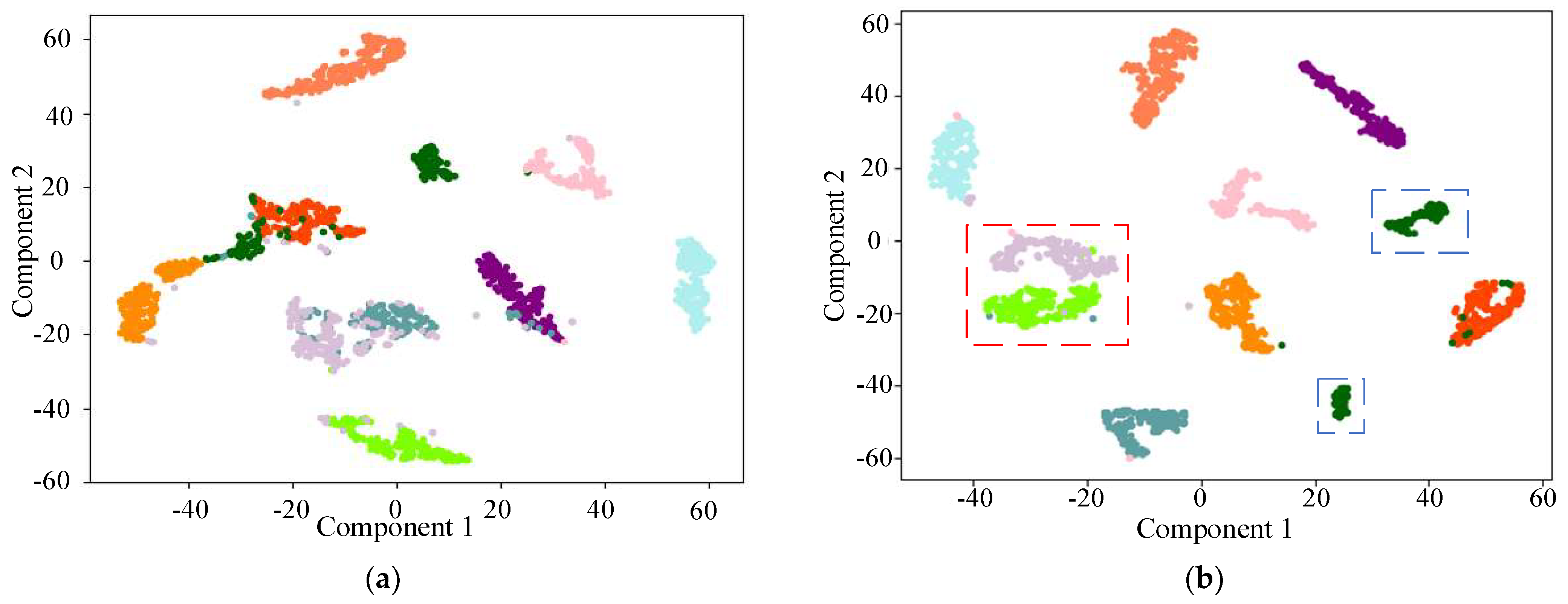
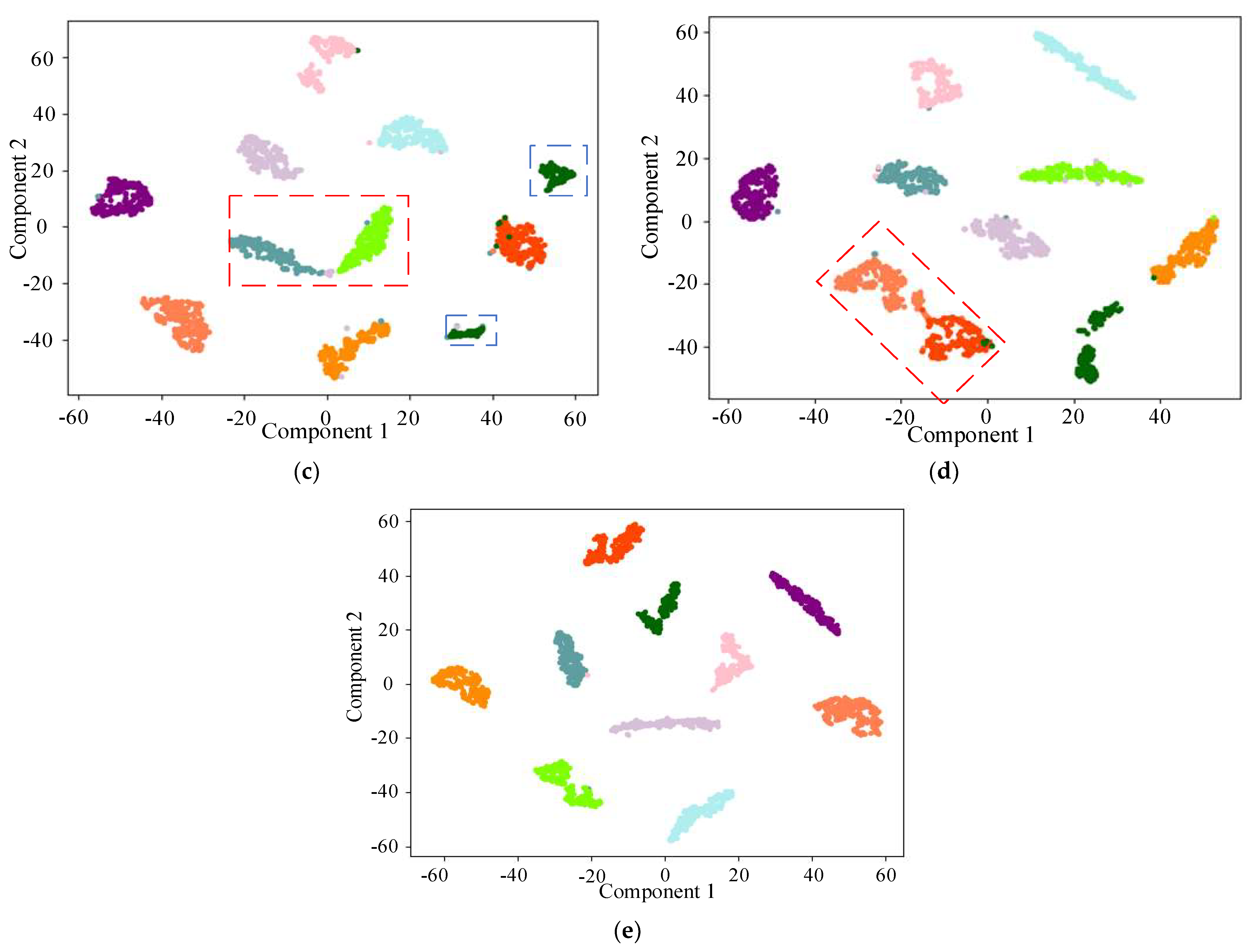
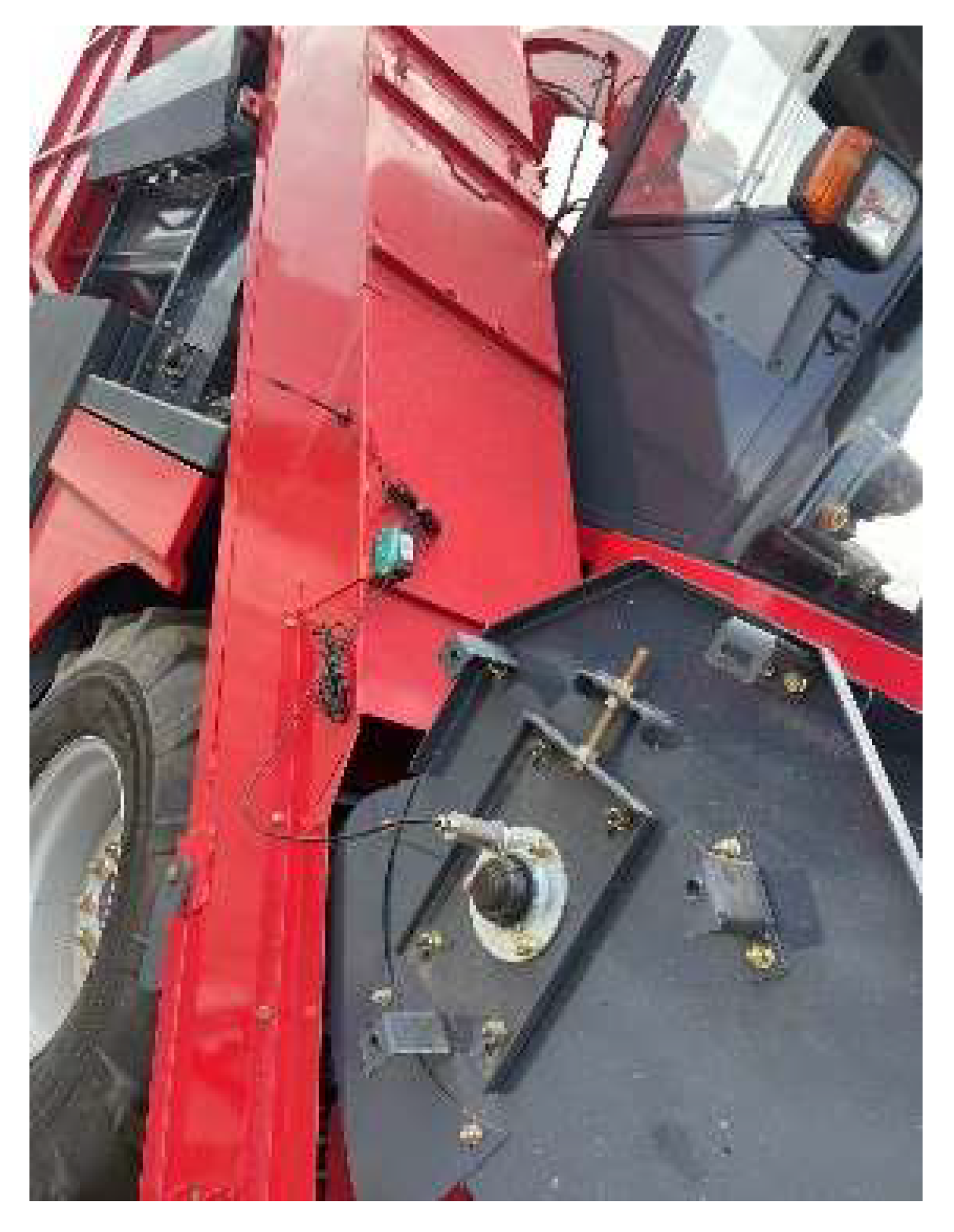
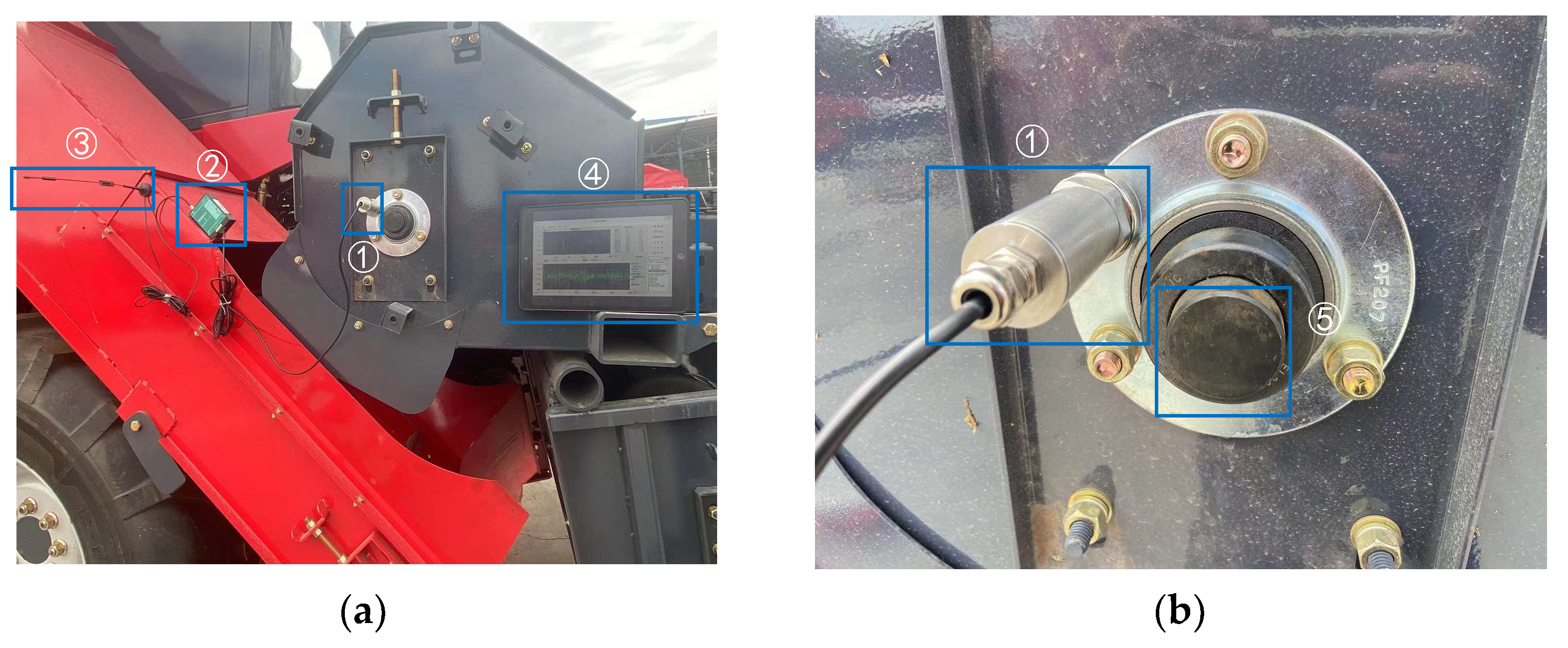
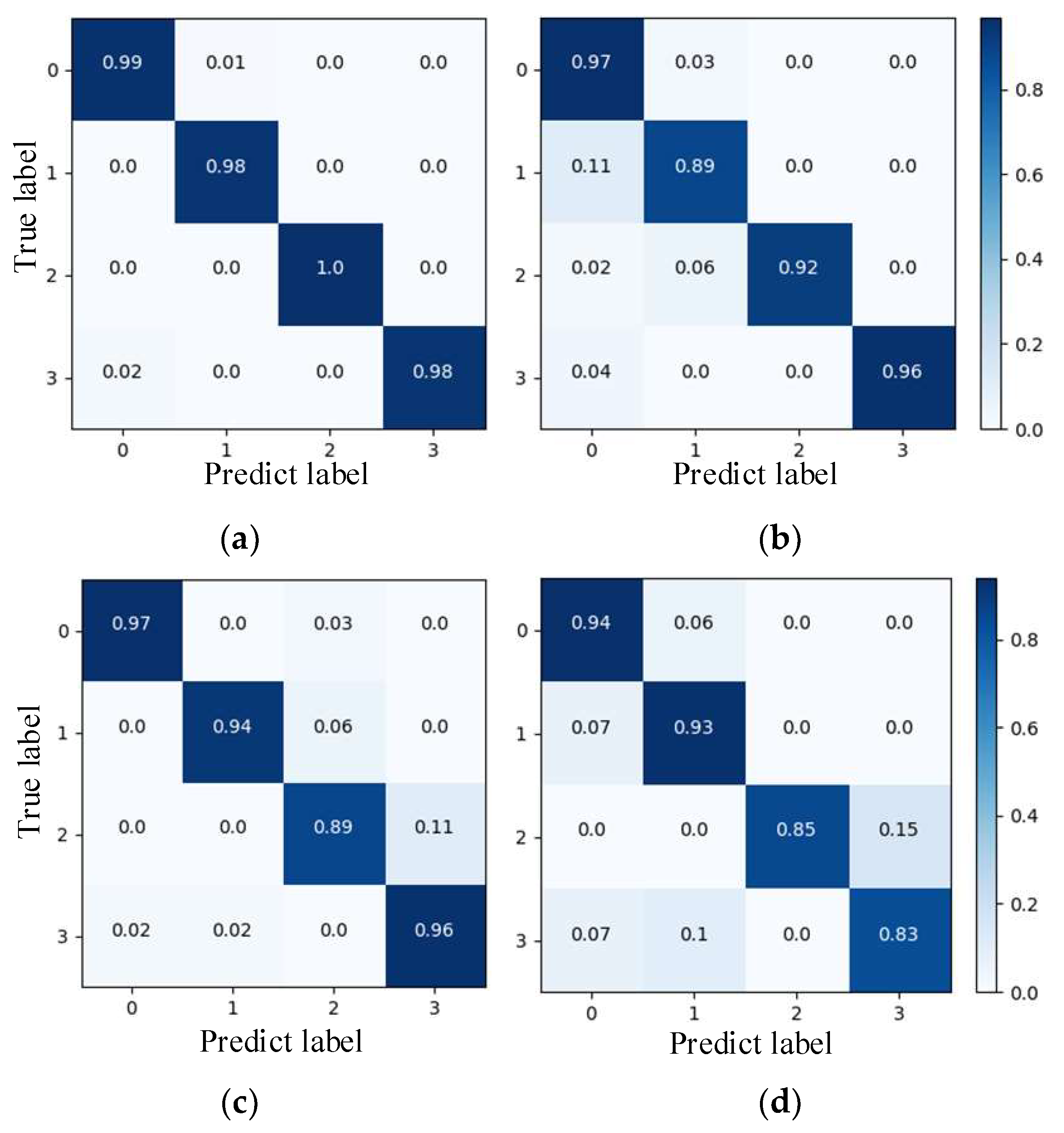
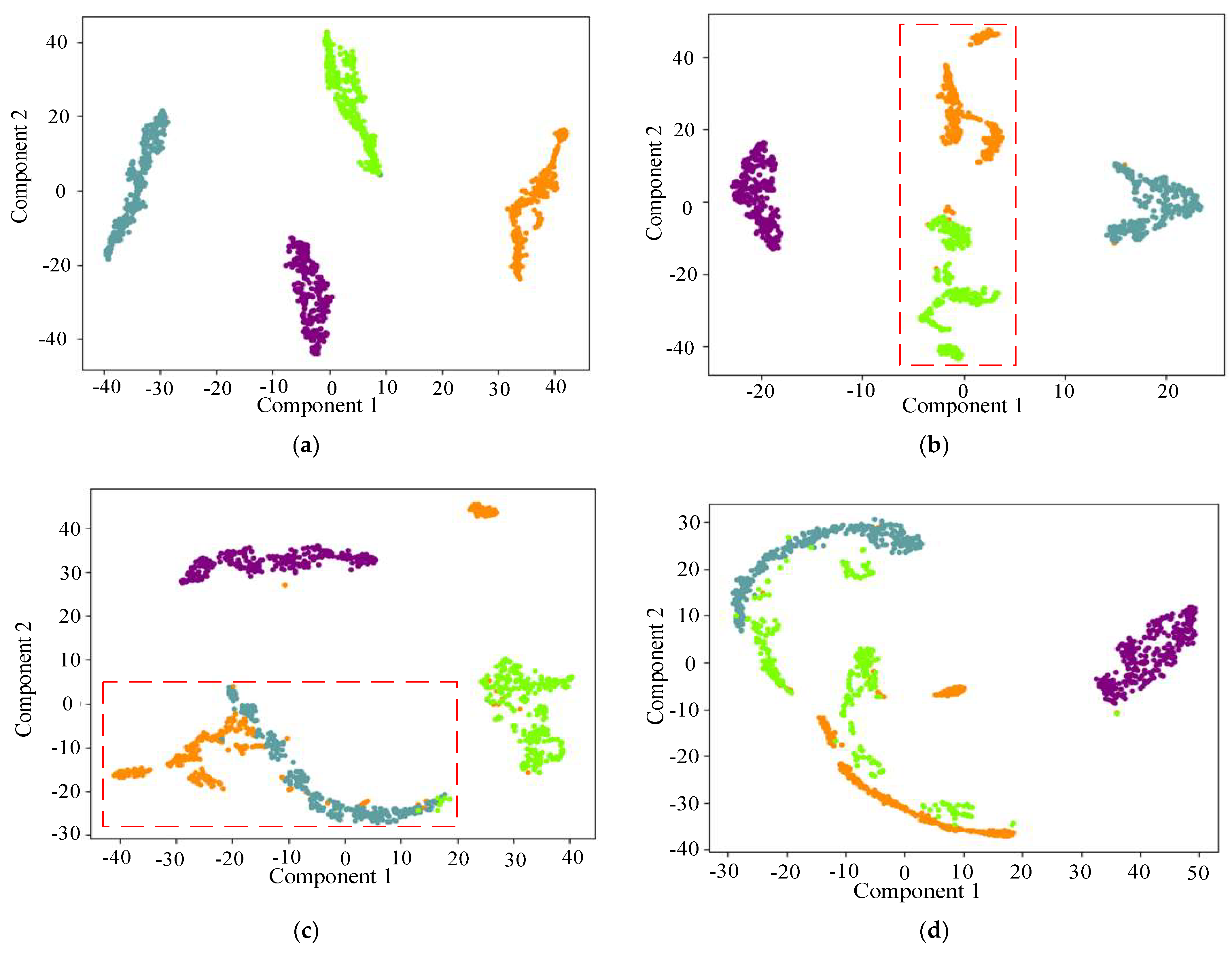
| Fault | Fault Diameter (inch) | Label | Count of Samples | Training Set | Testing Set |
|---|---|---|---|---|---|
| normal | 0 | 0 | 9660 | 6720 | 2940 |
| inner ring failure | 0.007 | 1 | |||
| 0.014 | 2 | ||||
| 0.021 | 3 | ||||
| outer ring failure | 0.007 | 4 | |||
| 0.014 | 5 | ||||
| 0.021 | 6 | ||||
| ball defects | 0.007 | 7 | |||
| 0.014 | 8 | ||||
| 0.021 | 9 |
| IMF | PE | SNR | PSD Mean | Score |
|---|---|---|---|---|
| IMF1 | 0.557 | 1.244 | 2.207 | 1.1727 |
| IMF2 | 0.521 | 0.687 | −0.100 | 0.2093 |
| IMF3 | 0.565 | 0.679 | −0.445 | 0.093 |
| IMF4 | 0.540 | −0.205 | −0.534 | −0.3707 |
| IMF5 | 0.536 | −0.664 | −0.559 | −0.6069 |
| IMF6 | 0.537 | −1.741 | −0.566 | −1.1477 |
| Fault | Label | Count of Samples | Training Set | Testing Set | |
|---|---|---|---|---|---|
| Normal | 0 | 7700 | 5600 | 2100 | |
| inner ring failure | 1 | ||||
| outer ring failure | single point fault | 2 | |||
| multi-point fault state | 3 |
Disclaimer/Publisher’s Note: The statements, opinions and data contained in all publications are solely those of the individual author(s) and contributor(s) and not of MDPI and/or the editor(s). MDPI and/or the editor(s) disclaim responsibility for any injury to people or property resulting from any ideas, methods, instructions or products referred to in the content. |
© 2023 by the authors. Licensee MDPI, Basel, Switzerland. This article is an open access article distributed under the terms and conditions of the Creative Commons Attribution (CC BY) license (https://creativecommons.org/licenses/by/4.0/).
Share and Cite
Liu, Z.; Sun, W.; Chang, S.; Zhang, K.; Ba, Y.; Jiang, R. Corn Harvester Bearing Fault Diagnosis Based on ABC-VMD and Optimized EfficientNet. Entropy 2023, 25, 1273. https://doi.org/10.3390/e25091273
Liu Z, Sun W, Chang S, Zhang K, Ba Y, Jiang R. Corn Harvester Bearing Fault Diagnosis Based on ABC-VMD and Optimized EfficientNet. Entropy. 2023; 25(9):1273. https://doi.org/10.3390/e25091273
Chicago/Turabian StyleLiu, Zhiyuan, Wenlei Sun, Saike Chang, Kezhan Zhang, Yinjun Ba, and Renben Jiang. 2023. "Corn Harvester Bearing Fault Diagnosis Based on ABC-VMD and Optimized EfficientNet" Entropy 25, no. 9: 1273. https://doi.org/10.3390/e25091273
APA StyleLiu, Z., Sun, W., Chang, S., Zhang, K., Ba, Y., & Jiang, R. (2023). Corn Harvester Bearing Fault Diagnosis Based on ABC-VMD and Optimized EfficientNet. Entropy, 25(9), 1273. https://doi.org/10.3390/e25091273





